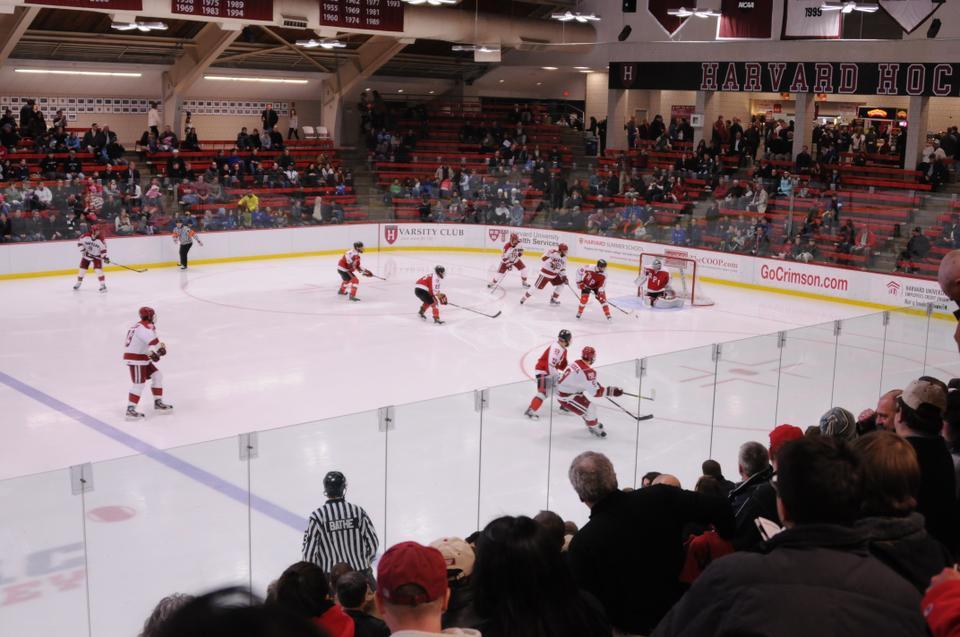
News
Summers Will Not Finish Semester of Teaching as Harvard Investigates Epstein Ties

News
Harvard College Students Report Favoring Divestment from Israel in HUA Survey

News
‘He Should Resign’: Harvard Undergrads Take Hard Line Against Summers Over Epstein Scandal

News
Harvard To Launch New Investigation Into Epstein’s Ties to Summers, Other University Affiliates

News
Harvard Students To Vote on Divestment From Israel in Inaugural HUA Election Survey
Complete Reversal
Following an average 2010-11 campaign, the Harvard men’s hockey team’s power play is now on pace to become one of the top 20 of all time

At its finest, hockey is art. It’s five men moving completely in-sync with one another. It’s subtle beauty in constant motion, punctuated by jarring chaos and back-breaking violence. If hockey is art, then consider this year’s power play Harvard coach Ted Donato ’91 and company’s “Guernica.”
In scoring 29 goals on 98 opportunities (29.6 percent), the Crimson’s (8-7-10, 7-4-8 ECAC) power play of senior Alex Killorn, junior co-captain Danny Biega, juniors Marshall Everson and Alex Fallstrom, and freshman Patrick McNally is not only the best in program history, but is currently leading the nation in efficiency and is on pace to be one of the 20 best power plays of all-time. It all started just over a year ago, when Donato decided to set aside a rigid structure and let his players’ artistic creativity shine.
“We basically stepped back and looked for what the best pieces we could put in place were,” Donato said. “We gave the guys a little structure, and within that structure, we gave them a lot of freedom for creativity. And they’ve done a great job with it.”
The change yielded almost immediate results. Harvard raised a nine percent conversion rate coming into last year’s Beanpot to 19.4 percent by the end of the season, which was good enough for 18th nationally. The improvement had a very noticeable effect on the team’s overall performance, as the Crimson went from being 4-18-0 before the switch to 8-4-1 after.
“At the end of last year we really started to get going on the power play,” Killorn said. “That helped us a lot coming into this year because we knew a lot of the players were the same. We expected sustained success.”
Donato hasn’t totally abandoned the structure that defined Harvard’s power play before the change, but instead has opted to offer players freedom within their prescribed roles. (See above info graphic for role description).
“Everyone has a certain role and responsibility, those are understood,” Biega said. “At the same time, if you have to break off from that role to create a scoring chance, there’s a little more flexibility.”
That flexibility has led to Everson, whose primary responsibility is to screen the goalkeeper’s vision, to score six goals on the power play, compared to just three in traditional five-on-five situations.
“[Marshall does things that you] don’t necessarily get a lot of credit for, like standing in front of the net and screening the goalie,” Biega said. “Those don’t really show up on the score sheet, but without Marshall our power play would not be as effective as it is.”
Similarly, McNally, a defenseman whose focus is preventing the short-handed opponents from breaking, has scored all four of his goals this season with a one-man advantage.
Despite its success on the power play, the Crimson offense is still only fifth in the ECAC in overall production, and had yet to score a short-handed goal until the third period against Northeastern on Monday–the first since last year’s Beanpot.
“We haven’t scored as many five-on-five goals as would reflect how well we’ve been playing five-on-five,” Everson said. “On the other hand, on the power play, even when we’re not playing that great it just seems like we’ll get one or two goals. It seems like the breaks and bounces we get always come on the power play.”
Though luck has played a role, attributing the bulk of the responsibility for Harvard’s success to mere chance discredits a tangible confidence the players have when on the power play.
“Just knowing that we’ve been so successful on the power play can give you some momentum in the sense that if you’re down, you know you have a chance to be up,” Biega said. “At the same time, you can’t rely on it to get you out of trouble.”
Therein lays the biggest problem for the Crimson this season. An over-reliance on the power play to get the team out of trouble has led to a program-record ten ties.
“A good power play scores at the right time,” Donato said. “We’re still chasing that a little bit. We have scored in the third period a little bit, as of late. But that’s something that I think can help us win games.”
With just four regular-season games left on the schedule, chances are good that Harvard’s power play will maintain the top spot nationally and remain a potent weapon for a team very much in the thick of things in the ECAC. But that doesn’t mean the Crimson is content with having one of the 20 best power plays of all-time.
“I honestly think we can improve our numbers on the power play,” Everson said. “Coach Donato has been really good about constantly improving the power play and not getting too stagnant. [We’re] pushing to keep improving and making it harder for other teams to play against us.”
—Staff writer Alexander Koenig can be reached at akoenig@college.harvard.edu.
Want to keep up with breaking news? Subscribe to our email newsletter.
